| Article ID | Journal | Published Year | Pages | File Type |
|---|---|---|---|---|
| 5078195 | International Journal of Industrial Organization | 2011 | 13 Pages |
Abstract
A significant amount of research on patent licensing and the diffusion of knowledge is organized around static frameworks of analysis. Patent holders, however, may face a dynamic problem, namely the intertemporal consistency problem of the durable-goods monopolist that is induced by durability on the demand side. Licensing practices such as exclusive licensing contracts and most favored customer clauses allow patentees to solve or mitigate this dynamic consistency problem. There are situations, however, where these practices are not possible either due to the nature of the patent (the case of information goods) or due to compulsory patenting laws. We study the effects of the intertemporal consistency problem on patent licensing in these situations. Relative to the existing literature, we obtain the following main results: (i) all of the firms that remain in the industry will be using the innovation; (ii) royalty licensing may be superior to fixed-fee or auction licensing from the licensor's point of view; (iii) social welfare and consumer surplus may be lower than when the patent holder can commit not to make additional sales; (iv) even for non-drastic innovations, the price of the good that is produced may be lower than the competitive price corresponding to the initial situation (before the innovation was discovered).
Related Topics
Social Sciences and Humanities
Economics, Econometrics and Finance
Economics and Econometrics
Authors
Ana I. Saracho,
